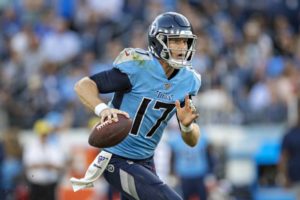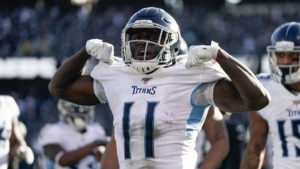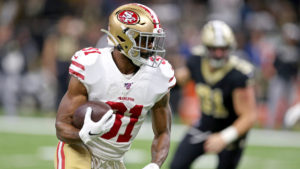Top Five 2020 Efficiency Regression Candidates
Here are the top efficiency regression candidates for the 2020 fantasy football season. In this case, when defining efficiency regression, we’re looking at touchdown rate, production premium, and yards per touch. Even if these players are really good in 2020, they won’t match their 2019 numbers. These are five players, plus a bonus honorable mention player, that are due for regression based on their production and efficiency metrics.
Austin Ekeler, RB, Los Angeles Chargers
Austin Ekeler is too good to sit on the benchpic.twitter.com/y3f9r0O2Gi
— Ian Hartitz (@Ihartitz) October 6, 2019
Austin Ekeler was the definition of efficiency last season. In 2019, Ekeler had 132 carries, 557 rushing yards, and three touchdowns. He added in 92 receptions, 993 receiving yards, and eight touchdowns. That resulted in 224 touches for 1,550 total yards and 11 total touchdowns. He was ranked first with 6.92 yards per touch last season. He also had a notable 85.2% catch rate, which was a career-high. Now that Melvin Gordon is gone, Ekeler should be the lead back coming into the 2020 season. Ekeler’s 92 receptions ranked 10th in the NFL sandwiched in between Cooper Kupp and Tyler Boyd.
Advanced Metrics & Snap Share
When looking at yards after the catch, he ranked second only behind Christian McCaffrey with 940 yards. According to Pro Football Reference, he also led all receivers with 15 broken tackles. It’s interesting to see Ekeler lead in broken tackles as a smaller guy at 5’10” and 200 pounds. Ekeler was also ranked first in production premium according to Player Profiler. Production Premium is an efficiency metric that “compares the outcome of all pass attempts, carries, and targets to league-average outcome in those same game situations (yard line, down, and distance).” Ekeler had a +54.5 production premium, which made him the most efficient running back using that metric.
According to Player Profiler, Ekeler had a 57.1% snap share (ranked 18th) and 46% opportunity share (ranked 33rd). However, Melvin Gordon came back in Week 5 and those were Ekeler’s season-long shares. In Weeks 1-5, Ekeler’s snap share ranged from 65-75%. In Week 5, Ekeler dominated the receiving game with 15 catches for 86 yards while still having a 66% snap share. Throughout the rest of the year, Ekeler’s snap shares ranged from 45-59% outside of Week 9 where he had 34% of the snaps.
10 Players My 2020 Fantasy Football Projections Are Higher On Than Consensus
Outlook for 2020
Gordon is now on the Denver Broncos, and it leads to many questions. Does Ekeler take most of the snaps and carries in 2020? We know he’s a threat in the receiving game. Does he share with Justin Jackson and/or rookie Josh Kelley? How will the offense be different without Philip Rivers? Last season, Rivers targeted Ekeler and Gordon on 28% of his pass attempts. The offense as a whole might take a step back with Tyrod Taylor or rookie Justin Herbert battling for the quarterback spot.
See Where Ekeler Lands In Our 2020 Running Back Rankings!
If the offensive production goes down, then Ekeler’s efficiency would likely also go down. Or the Chargers could rely on Ekeler as their lead back and the volume could lead to production. Regardless, Ekeler’s efficiency won’t be the same as in 2019. Ekeler has a NFFC ADP of 15 as the 11th running back off the board sandwiched between Miles Sanders and Josh Jacobs. If he gets more snaps and touches in 2020, then he could solidify RB1 status, yet it seems unlikely given the team changes.
Aaron Jones, RB, Green Bay Packers

Aaron Jones is another smaller back that’s an efficiency regression candidate. He’s listed at 5’9″ 208 pounds and very productive with over 1,500 total yards last season. Jones had 236 carries, 1,084 rushing yards, and 16 rushing touchdowns. The 16 rushing touchdowns reek of regression.
He also had 49 receptions, 474 receiving yards, and three receiving touchdowns. Last season, Jones tied with Derrick Henry with 16 rushing touchdowns. Christian McCaffrey was the only other running back with 19 total touchdowns last season. McCaffrey’s touchdown rate was 4.7%, but his opportunity share was 91.5%. Jones’ touchdown rate of 6.7% is likely unsustainable with the amount of touches he received.
Advanced Metrics & Snap Share
Jones had the majority of snaps and opportunities with a 62.6% snap share and a 62.2% opportunity share. He shared the backfield with Jamaal Williams, and fans clamored for the Free Aaron Jones movement. Aaron Jones averaged 14.8 carries per game and 4.3 targets per game. That ranked top-15 in carries/game and top 11 in targets per game at running back. His 19.7 fantasy points per game ranked third amongst running backs.
Jones can be elusive and break tackles. Last season he ranked fourth in evaded tackles with 86 and ranked eightth in juke rate at 30.2%. In terms of production premium, he ranked seventh amongst running backs. In another efficiency metric called dominator rating, Jones ranked third at 35%. Dominator Rating is “a running back’s percentage of total team yards and team touchdowns generated on offense.” Overall, Jones was efficient and productive last season.
Why I’m Buying Brandin Cooks In All Of My Leagues (And You Should Too)
Outlook for 2020
Jones has a NFFC ADP of 11. He’s sandwiched between Joe Mixon and Lamar Jackson and goes as the eighth running back off the board. Jones is a touchdown regression candidate, but can we expect similar total yardage as last year? Also, why did the Packers draft A.J. Dillon in the second round? Dillon was a workhorse in college listed at 6’0” and 247 pounds. At Boston College last year, he had 318 carries, 1,685 rushing yards, and 15 total touchdowns. If Jones is a touchdown regression candidate, could Dillon or Williams steal some of the red zone and goal-line touches? If that ends up being the case, then Jones’ overall production could decrease as well.
Lamar Jackson, QB, Baltimore Ravens
 Lamar Jackson led the NFL with 36 passing touchdowns and a 9% passing touchdown rate. Before we go any further, let’s appreciate how filthy Lamar was last season. He threw 36 touchdowns, six interceptions, and 3,127 passing yards. Jackson also had 176 carries for 1,206 rushing yards and 7 rushing touchdowns. That’s 4,333 total yards and 43 total touchdowns for the reigning NFL MVP. Those are league winning numbers right there.
Lamar Jackson led the NFL with 36 passing touchdowns and a 9% passing touchdown rate. Before we go any further, let’s appreciate how filthy Lamar was last season. He threw 36 touchdowns, six interceptions, and 3,127 passing yards. Jackson also had 176 carries for 1,206 rushing yards and 7 rushing touchdowns. That’s 4,333 total yards and 43 total touchdowns for the reigning NFL MVP. Those are league winning numbers right there.
Advanced Metrics
In terms of pass plays per game and passing attempts, Jackson ranked in the bottom of the league. When looking at team pass plays per game, the Ravens were last. In passing attempts, he ranked 26th. Basically, Jackson had elite passing game production with some of the lowest passing opportunities. In terms of rushing production, Jackson ranked first in almost all production metrics amongst quarterbacks except for rushing touchdowns. Josh Allen led quarterbacks with nine rushing touchdowns, and Jackson tied with Deshaun Watson with seven. When looking at efficiency metrics, Jackson ranked second in Production Premium at +40.3 amongst quarterbacks. Ryan Tannehill ranked first at +54.9.
Outlook for 2020
We know that Jackson is the quarterback cheat code with the rushing yards. However, last season he was extremely productive in the passing game in terms of passing touchdowns. Since Jackson runs as much as he does, it’s probably fair to expect his passing volume to stay relatively the same. However, his current NFFC ADP is a first-rounder at pick 10. If it were a Superflex league, then that’s reasonable even if he regressed in the passing touchdown department. In a 1-QB league, this first-round price is steep.
Ryan Tannehill, QB, Tennessee Titans
 Let’s look at Ryan Tannehill, who took over the quarterback job in Week 7. He played a bit in Week 6, but the following week was when he solidified himself as the Titans quarterback. We know that the Titans had Derrick Henry dominating the run game, so Tannehill’s passing opportunities were limited. Last season, Tannehill threw 2,742 passing yards, 22 passing touchdowns, and 6 interceptions. He also used his legs a bit with 43 carries, 185 rushing yards, and four rushing touchdowns.
Let’s look at Ryan Tannehill, who took over the quarterback job in Week 7. He played a bit in Week 6, but the following week was when he solidified himself as the Titans quarterback. We know that the Titans had Derrick Henry dominating the run game, so Tannehill’s passing opportunities were limited. Last season, Tannehill threw 2,742 passing yards, 22 passing touchdowns, and 6 interceptions. He also used his legs a bit with 43 carries, 185 rushing yards, and four rushing touchdowns.
Advanced Metrics
In terms of passing attempts, Tannehill ranked 29th amongst quarterbacks. Tannehill ranked first in supporting cast efficiency, which aligns with another efficiency metric – production premium. A.J. Brown and Derrick Henry definitely contributed to Tannehill’s efficiency. His production premium was the highest amongst quarterbacks at +54.9. Tannehill was 28th in the league in terms of passing yards and completed air yards. His 7.7% passing touchdown rate ranked second only behind Lamar Jackson, another efficiency regression candidate. And Tannehill’s career touchdown rate is 4.5%, so don’t expect the same efficiency in 2020.
Tannehill to AJ Brown for a 91-yard TD.
Burnt the Raiders defense 💨
(via @NFL)pic.twitter.com/MHstvnAnXX
— B/R Gridiron (@brgridiron) December 8, 2019
Outlook for 2020
Will Tannehill regress or breakout in 2020? Could 2020 be the breakout season for the 31-year-old quarterback? If Tannehill played a full season, he was on pace for 4,300 passing yards and that would’ve been a career-high. His three-game stretch in the playoffs was awful but granted those games were against good defenses. In three games, he threw for 369 yards, five touchdowns, and one interception. In two of those games, he had less than 90 passing yards.
See Where Tannehill Lands In Our 2020 Quarterback Rankings!
Signs point to regression in efficiency for his touchdown rate and production premium. It’s difficult to keep up the efficiency and production with the Titan’s low volume passing game. Tannehill’s NFFC ADP is 110 and he’s the 17th quarterback off the board. If Tannehill’s touchdown rate regresses and he doesn’t throw for 4,000 plus yards, then this price is way too steep.
A.J. Brown, WR, Tennessee Titans
 We can’t talk about Tannehill’s regression without talking about A.J. Brown. Brown finished with 52 catches on 84 targets, 1,051 receiving yards, and 8 touchdowns. That averaged out to 20.21 yards per reception. He had five games with 100 plus receiving yards and eight games with 45 yards or less including five games with under 30 yards. There’s definitely volatility there with a high ceiling and low floor. For the first eight weeks of the season, he didn’t have a 65% snap share. From Weeks 9-16, his snap share ranged from 69-100%.
We can’t talk about Tannehill’s regression without talking about A.J. Brown. Brown finished with 52 catches on 84 targets, 1,051 receiving yards, and 8 touchdowns. That averaged out to 20.21 yards per reception. He had five games with 100 plus receiving yards and eight games with 45 yards or less including five games with under 30 yards. There’s definitely volatility there with a high ceiling and low floor. For the first eight weeks of the season, he didn’t have a 65% snap share. From Weeks 9-16, his snap share ranged from 69-100%.
Advanced Metrics
According to Player Profile, he had a 72.3% snap share, which ranked 65th at wide receiver. Brown’s opportunity metrics weren’t great in terms of pass plays per game (ranked 30th) and 5.2 targets per game (ranked 47th). This shouldn’t be surprising because of the lower volume passing offense for the Titans.
In terms of productivity, there were some mixed numbers. Brown’s receiving yards ranked 21st at wide receiver, yards after catch at 447 yards ranked 6th, and total touchdowns ranked 3rd. His touchdown rate was at 15.4%, which screams regression due to the passing volume he receives.
Brown’s efficiency metrics of yards per reception and yards per target both ranked 3rd at receiver. His catch rate was 61.9% which ranked 61st, and his true catch rate ranked 79th at 77.6%. True catch rate is defined as the “reception percentage-based solely on catchable targets.” Brown’s Production Premium metric was first amongst receivers at +52.4. It’s hard to sustain extreme efficiency and production for a wide receiver that gets 5-6 targets per game.
Outlook for 2020
A rookie receiver with a 1,000-yard season and eight touchdowns is exciting. However, a 61.9% catch rate, extreme efficiency, and low targets are concerning. Another concern is his current draft price of 39 NFFC ADP, which is a high price to pay with that volatility. Allen Robinson and Chris Carson are two guys going around him, and they both provide more volume and consistency. Brown is the 14th receiver off the board, which is a high price to pay for a low volume receiver.
Honorable Mention, Raheem Mostert, RB, San Francisco 49ers
 As a five year veteran, Raheem Mostert had a career season. Mostert had 137 carries, 772 rushing yards, and eight touchdowns. He also chipped in 14 receptions, 180 receiving yards, and two touchdowns. On the season, he had ten total touchdowns with a 6.6% touchdown rate. When looking at his game logs, he burst onto the scene in weeks two and three, then came back onto the scene in weeks 12-16. In those seven weeks, Mostert had 89 carries, 541 rushing yards, and six rushing touchdowns. He also chipped in nine receptions, 137 receiving yards, and two receiving touchdowns.
As a five year veteran, Raheem Mostert had a career season. Mostert had 137 carries, 772 rushing yards, and eight touchdowns. He also chipped in 14 receptions, 180 receiving yards, and two touchdowns. On the season, he had ten total touchdowns with a 6.6% touchdown rate. When looking at his game logs, he burst onto the scene in weeks two and three, then came back onto the scene in weeks 12-16. In those seven weeks, Mostert had 89 carries, 541 rushing yards, and six rushing touchdowns. He also chipped in nine receptions, 137 receiving yards, and two receiving touchdowns.
Advanced Metrics and Snap Share
According to Player Profiler, Mostert’s 36.4% snap share ranked 54th and 32.2% opportunity share ranked 55th. Understand that those snap and opportunity shares were season long. However, he only had one week with a snap share above 60% during his most productive seven weeks. So even in those productive weeks, he shared snaps and touches with other backs. The 49ers were one of the most run-heavy teams with 31.1 team runs per game, which ranked 2nd. The running opportunities are there, but it’s just split amongst the backs.
Mostert was extremely efficient with 5.1 true yards per carry that ranked first and 6.3 yards per touch that ranked fourth amongst running backs. True yards per carry discounts runs of 10 yards or more and rewards consistency. He’s fast, and ranked sixth in breakaway runs and first in breakaway run rate. Breakaway runs are defined as runs of 15 yards or more, so he can be explosive. Mostert had the third-best production premium amongst running backs at +35.6. Yet he ranked 33rd in carries and 26th in rushing yards last season.
Raheem Mostert.
That's it. That's the tweet.#BeLegendary pic.twitter.com/xirNLEvbBF— San Francisco 49ers (@49ers) January 20, 2020
Outlook for 2020
Mostert might have been on and off waivers in 2019. However, in 2020 drafts, he’s got a 52 NFFC ADP as the 26th running back off the board. Mostert’s draft price is the back end RB2 range, which is too high for a guy that averaged a 36.4% snap share. He had one week last year with a 74% snap share. Outside of that one week, he didn’t receive 60% of the snaps in any other week. The 49ers backfield is exciting, but it’s split amongst their backfield. Matt Breida is now on the Dolphins, but Tevin Coleman is still there. Jeff Wilson and Jerrick McKinnon could also steal some touches in 2020.




